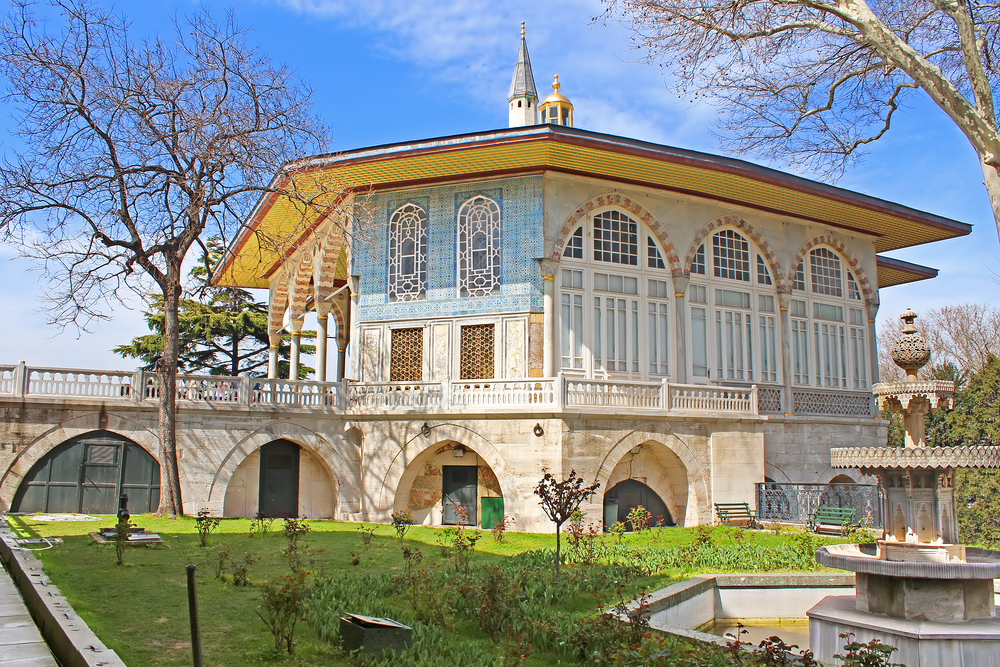Few homes hold as many intriguing untold stories as the 15th Century BC Topkapi Palace Museum in Istanbul’s Fatih district. Here, Ottoman sultans entertained concubine slaves, engaged in fierce power struggles within the harem, and castrated eunuchs served their masters. Sibling rivalry over the throne sometimes resulted in tragic outcomes for family members. For nearly four centuries, Topkapi was the heart of the Ottoman Empire until the dynasty relocated to Dolmabahce Palace. However, the Topkapi Palace Museum offers far more than just its stunning architecture; it stands as a testament to the generations of the Ottoman royal family whose actions shaped world history and touched millions of lives.
About Topkapi Palace Museum in Istanbul
From the 15th until the early 20th Century, the Ottoman sultans made Topkapi Palace their home. At its peak, this powerful family governed vast territories from Topkapi, transforming it into a bustling mini-city within Constantinople. This significance has earned Topkapi Palace its status as a UNESCO World Heritage site in Istanbul.
The First Ottoman Sultan Mehmed II
Sultan Mehmed II, known as Mehmed the Conqueror, played a vital role in the history of Topkapi Palace. He captured Constantinople (now Istanbul) in 1453, marking the end of the Byzantine Empire and the beginning of Ottoman rule. Following the conquest, Mehmed II established the city as his new capital and built Topkapi Palace as his main residence and administrative center, on the grounds of the ancient Byzantine Acropolis, overlooking the Golden Horn and the Marmara Sea.
Topkapi Palace During the 18th Century
The 18th Century saw extensive renovations to Topkapi Palace under Sultan Ahmed III (r. 1703-1730), who commissioned new buildings, pavilions, and courtyards that echoed Baroque and Rococo styles. Although Topkapi remained the sultans’ primary residence, the Ottoman’s political power began to wane during this period, as governance shifted towards other influential centers and institutions.
During the 19th Century
The 19th Century brought significant upheaval to the Ottoman royal family. Sultan Selim III died at Topkapi Palace on July 28, 1808, during the Janissary Revolt—a violent uprising within the Ottoman military. Although he sought refuge in the palace’s harem, he was ultimately discovered and imprisoned, leading to his tragic end.
This century also saw Western influences permeate Ottoman architecture and design, introducing neoclassical and eclectic styles into the palace’s structures. Despite this, the decline of the Ottoman royal family continued, with sultans becoming largely ceremonial figures.
8 Interesting Facts about Topkapi Palace
- Ottoman Sultan Ibrahim, infamously nicknamed Crazy Ibrahim, once suspected 280 of his concubines of plotting against him. In a fit of paranoia, he had them tied in sacks and thrown into the Marmara Sea.
- The crown prince’s apartment building was once called the kafes, a place where sultans confined their brothers out of fear of rivalry. This isolation may have contributed to Ibrahim Sultan’s famously unstable mind.
- Selim II both lived and died at Topkapi Palace, passing away at the age of 50 due to his excessive drinking.
- Roxelana, a 15-year-old slave, captivated Sultan Suleiman the Magnificent and eventually became one of the most powerful women in Ottoman history.
- To maintain order within the harem, male slaves were often castrated to prevent affairs with concubines.
- Sultan Murad III, who fathered over 100 children, commenced his reign with the murder of five brothers to protect his throne—a brutal family strategy.
- Many harem slaves were encouraged by their parents to join, where they learned languages, etiquette, and skills like dancing and writing—often providing a better life than they’d have outside.
- Murad IV, a sadistic ruler who reigned until the age of 27, engaged in cruel pastimes such as shooting at slave women and ordering his doctor to overdose.
The Imperial Gate and First Courtyard
Visits to Topkapi Palace usually begin at the Imperial Gate, also known as the Royal Gate, located on the outer wall facing Sultanahmet Square. Visitors enter through the First Courtyard, which also housed the Court of the Janissaries and accommodated large crowds, showcasing the grandeur and authority of the empire.
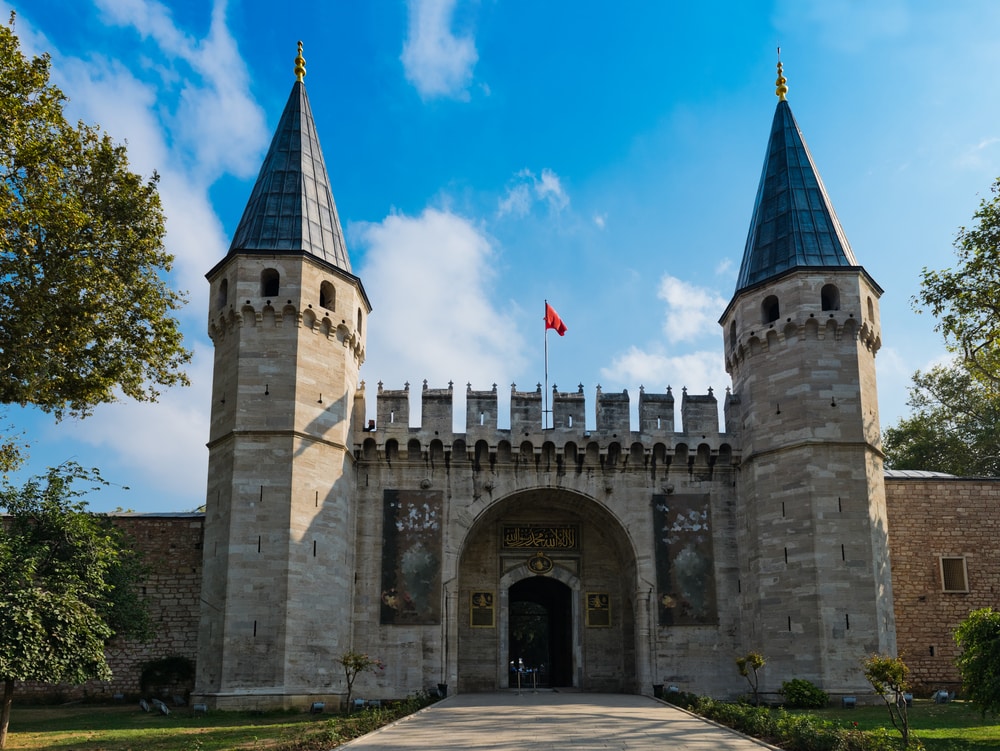
Here is where people gathered for significant events and processions. The First Courtyard also contained barracks and accommodations for the Janissaries, ensuring a strong military presence. Various ceremonies and military parades took place within this courtyard, highlighting the Ottoman military’s strength.
Second Courtyard of Topkapi Palace
The Second Courtyard, known as Divan Square, served as the primary administrative and ceremonial space of Topkapi Palace. Restricted to palace officials, government ministers, and authorized personnel, this courtyard featured numerous buildings catering to various functions. The heavily guarded Treasury stored the empire’s wealth, while the imperial council chamber was the site of crucial political discussions and decisions.
The second courtyard also housed the palace kitchens, responsible for preparing meals for the sultans, their families, and the vast staff. Additionally, administrative offices managed palace affairs and coordinated with different government branches. Visitors can also pay an extra fee to tour the harem section located in this courtyard.
Third Courtyard for the Ruling Elite
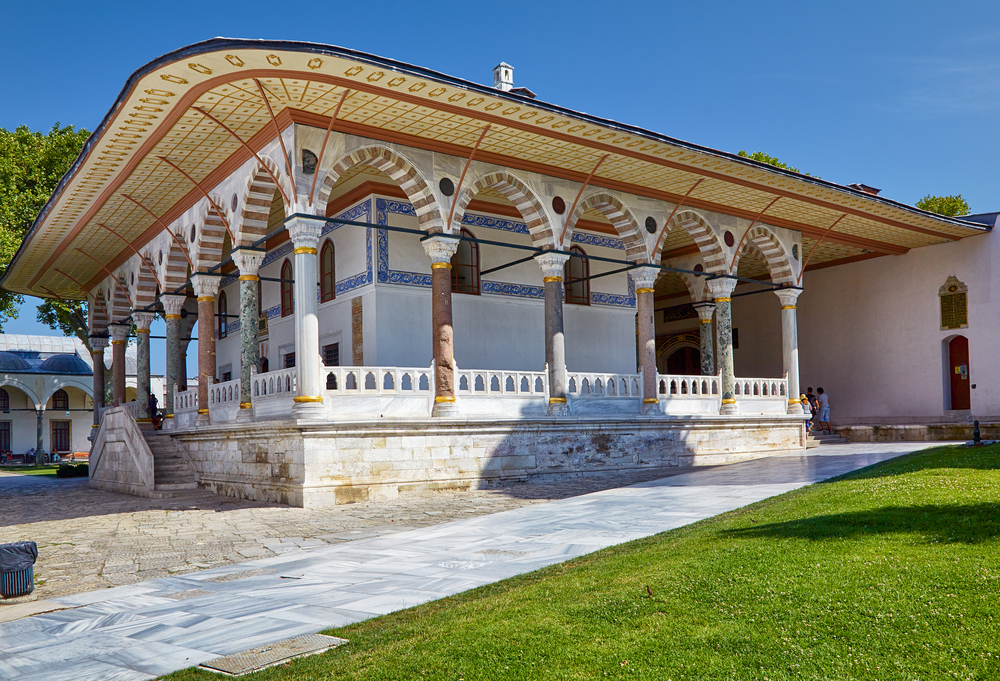
The third courtyard, referred to as the “Enderun Courtyard” or “Inner Palace Courtyard,” was where the Sultan spent considerable time outside the harem. The Gate of Felicity served as the entry point to the inner courtyards and chambers, marking the boundary between the public and the Sultan’s private world.
This beautifully adorned gate features intricate carvings and calligraphic inscriptions, safeguarded by elite Janissaries who controlled access to the palace grounds. It symbolized the Sultan’s authority, as important figures and dignitaries were received here. Today, visitors can still marvel at the Gate of Felicity in the third courtyard.
The layout further includes stunning gardens, pavilions, fountains, and architectural marvels. The Audience Chamber was used for official meetings and ceremonies, where the Sultan welcomed high-ranking officials and ambassadors. The library, built by Sultan Ahmed III in the 18th century, houses a collection of manuscripts and rare books, including a room dedicated to sacred relics.
Fourth Courtyard For the Sultans Only
The fourth courtyard was exclusively for the Sultan. Within this area lies the Baghdad Kiosk, a striking structure surrounded by terraced gardens. Built in the 17th century by Sultan Murad IV, this pavilion symbolizes the empire’s influence and reach, named after the city of Baghdad. The Circumcision Room was also situated here, dedicated to the ceremonial rites of young Ottoman princes.
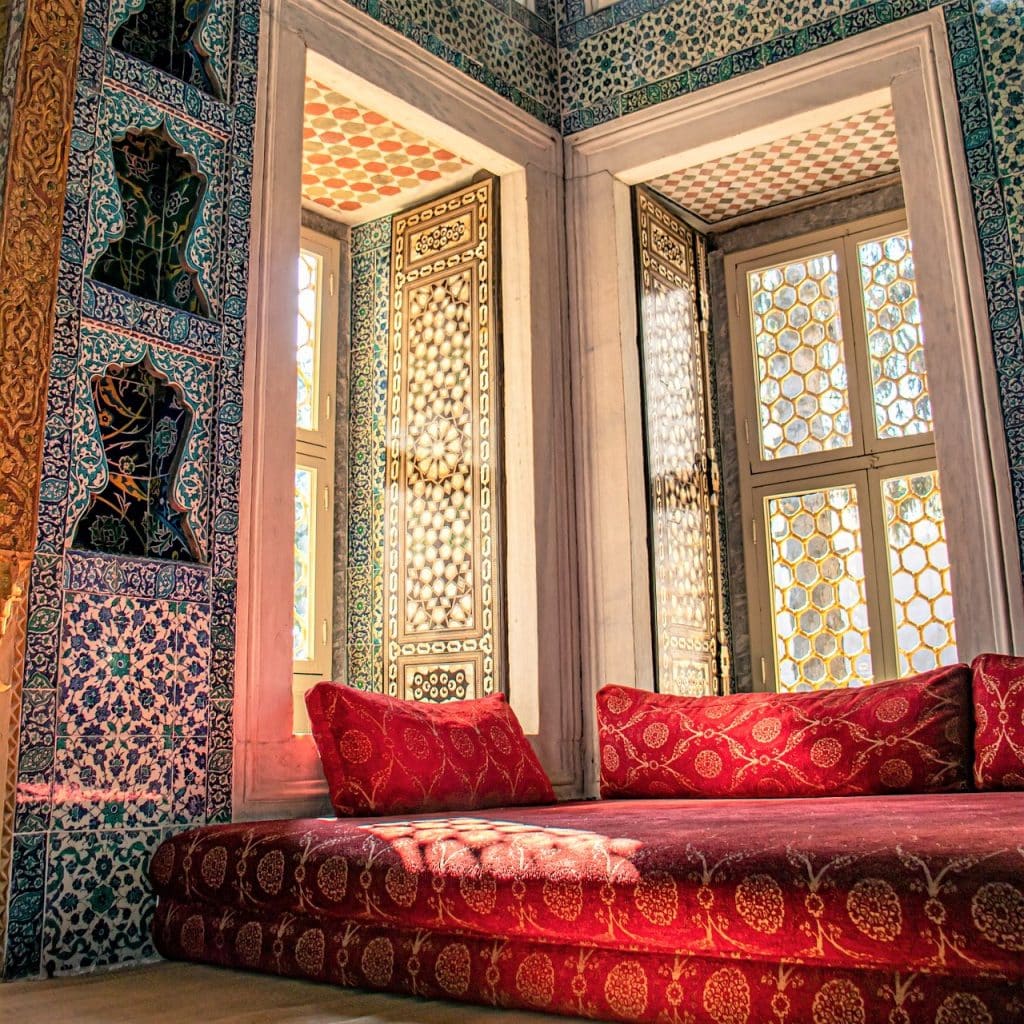
The Privy Chamber of Topkapi Palace
The Privy Chamber was the private residence of the Ottoman rulers and their families. It was secluded from the rest of the palace by additional walls and gates, ensuring a high degree of privacy. Within the Privy Chamber, there were several rooms, including the Sultan’s sleeping chambers, sitting rooms, and personal study.
Adjacent to the Sultan’s quarters were chambers for the Valide Sultan (the Sultan’s mother) and the concubines, highlighting the importance of the royal family. Lavishly decorated with intricate tiles and rich furnishings, the Privy Chamber represents the luxurious lifestyle of the Ottoman elite.
Behind the Doors of The Imperial Treasury
The Imperial Treasury at Topkapi Palace evokes immense wealth and luxury. This treasure trove includes gold and silverware, jewels, precious gemstones, manuscripts, ceremonial weapons, and artifacts from Ottoman history. The Treasury was heavily guarded and accessible only to the sultans, their advisors, and authorized personnel.
Among its treasures is a stunning 35 cm, 18th-century dagger adorned with 50 diamonds and three deep green emeralds. It was meant as a gift for the late Iranian conqueror Nadir Shah but was never delivered due to the assassination of the courier. The famous Topkapi Dagger gained further notoriety in 1964 with the film depicting a heist for its ownership.
Also on display is an impressive 18-carat, 17-kilogram diamond. Legend has it that this gem was found by a fisherman on the shores of the Bosphorus and sold to the 17th-century Sultan Mehmet, the Hunter. It is said the jeweler swindled the fisherman, giving him only three spoons in return.
Islamic Holy Relics and the Sacred Safekeeping Rooms
The sacred safekeeping rooms, housing Islamic holy relics, are located within the Privy Chamber and the third courtyard hall of Topkapi. Collected by Ottoman sultans from the 16th to 19th centuries, these revered pieces include the staff of Moses, scrolls from John the Baptist, and relics from the Prophet Muhammad. To ensure their safety, these artifacts are kept under strict preservation techniques, preventing direct contact.
The Imperial Harem of Topkapi Palace
Don’t miss the opportunity to tour the 16th-century harem—available for an additional fee. Linked through courtyards and fountain gardens, this educational experience dispels many common stereotypes about the harem. The Sultan’s consorts were trained and educated to meet the standards expected of royal women. The Valide Sultan, the Sultan’s mother, played a pivotal role in decision-making and exerting influence over the imperial court.
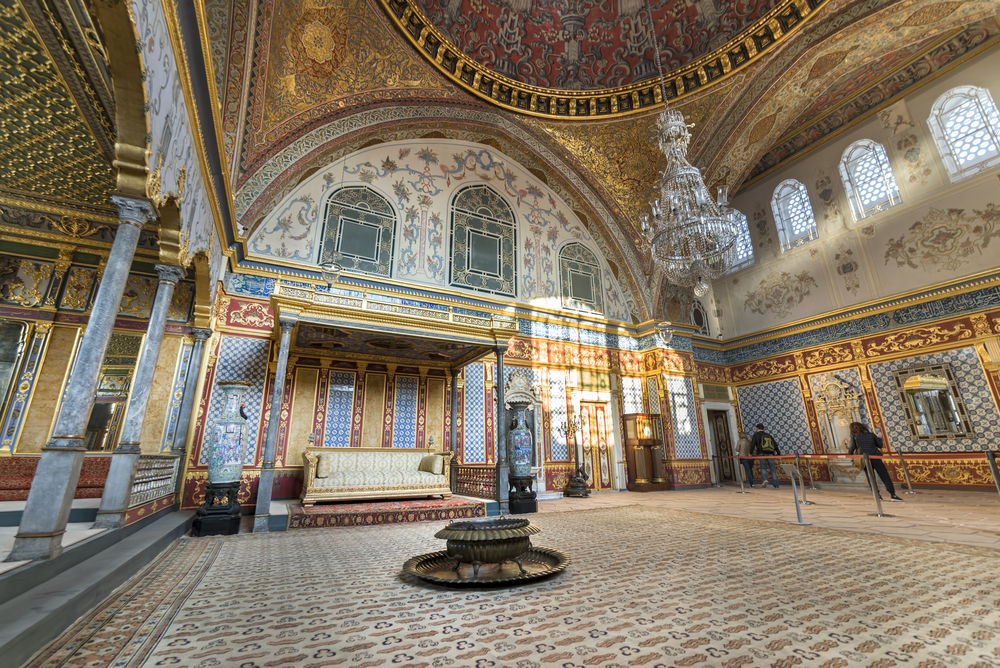
Within the harem, a hierarchy existed, with the queen mother presiding over her court, supported by officials, servants, and attendants. The Sultan valued her opinions, and the Valide Sultan often had a significant impact on matters concerning the imperial family. Visitors enter the harem through the Cart Gate, which leads past the Eunuch courtyard, document archives, harem baths, and the Queen Mother’s apartments, concluding the tour in the third courtyard.
Role of the Royal Pages
Topkapi Palace employed a large staff, including royal pages, who held significant responsibilities. Chosen for their intelligence, physical attributes, and loyalty, royal pages attended to the Sultan and his family, assisting with daily tasks and running errands within the palace. They also received education in languages, etiquette, and martial arts at the palace school.
Hagia Irene Church
Located within the outer courtyard near the Hagia Sophia, Hagia Irene (Ayasofya-i Kebir) dates back to the 4th Century, although the current structure was rebuilt in the 6th Century by Emperor Justinian I. For over a thousand years, it served as an Eastern Orthodox church and, in more recent times, has functioned as a concert venue.
Moving From Topkapi Palace to Dolmabahce Palace
Constructed in the mid-19th Century, Dolmabahce Palace was built during a time of modernization within the Ottoman Empire. The sultans relocated here as Topkapi Palace had come to symbolize older governance styles. This move marked a shift towards a more centralized and modern government.
Dolmabahce Palace’s design showcases a blend of European influences, particularly Neoclassical and Baroque aesthetics, reflecting the sultans’ desire to connect with European culture and present themselves as influential figures on the global stage. Unfortunately, their reign was short-lived. Following World War I and the Turkish War of Independence, the Ottoman Empire was dissolved—a story for another time. (Learn more about Dolmabahce Palace in Istanbul.)
Visit Topkapi Palace in Istanbul
Situated in European Istanbul, the expansive Topkapi Palace Museum overlooks the Bosphorus Straits and the entrance to the Golden Horn, with views extending over the Marmara Sea. It is located within the historic Sultanahmet area of the Fatih district, also known as Sarayburnu.
Surrounded by other iconic landmarks like the Blue Mosque, Hagia Sophia, and the Basilica Cistern, visitors can explore all these significant sites in one day, though two days would provide a richer experience. The palace is open to visitors from 9 a.m. to 6 p.m. during the summer and until 5:30 p.m. in the winter. Ensure you allocate enough time to fully appreciate the grandeur of Topkapi Palace during your visit.
